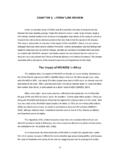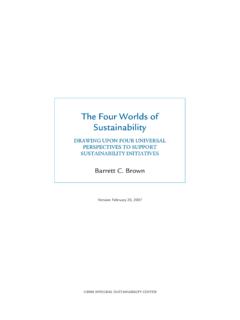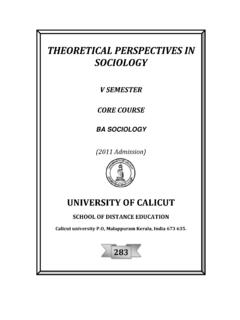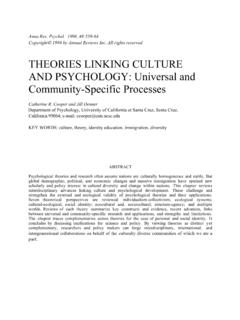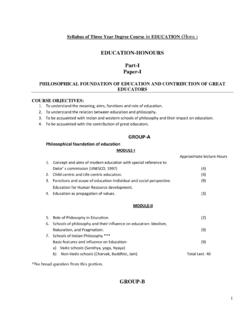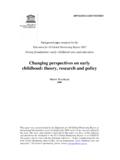Transcription of MOTIVATION IN EDUCATION - Learning Development Institute
1 MOTIVATION IN EDUCATION (Article by Diana Stirling, Associate Researcher, Learning Development Institute ) EDITORIAL NOTE The following article on MOTIVATION in EDUCATION by LDI Associate Researcher Diana Stirling was first published in a translated version in Japanese. It appears here for the first time in English, the language in which it was originally written. For citation purposes, the English version should reflect access via this site and should read as follows (MLA style): Stirling, Diana. " MOTIVATION in EDUCATION ." Learning Development Institute . 31 May 2014. Web. The reference for the originally published paper in Japanese is: Stirling, Diana. " MOTIVATION in EDUCATION .
2 " Aichi Universities English EDUCATION Research Journal. 29 (2013): 51-72. Trans. Mitsuo Kondo. Print. We thank the Aichi Universities English EDUCATION Research Journal for permission to publish this paper on the site in accordance with an agreement made with the author. Learning Development Institute , May 31, 2014 JV MOTIVATION in EDUCATION Diana Stirling Introduction This paper will explore current thought and research into MOTIVATION . We will look at theories of MOTIVATION in general and then focus on the tenets of Self-Determination Theory (SDT), in particular. Keeping the research in mind, we will address a number of questions: What inspires teachers, and what moves learners?
3 How do our Learning organizations and systems affect the MOTIVATION of groups and individuals? and How might future changes in formal Learning environments affect MOTIVATION ? Many discussions of MOTIVATION begin by making a distinction between intrinsic and extrinsic MOTIVATION . Intrinsic MOTIVATION is characterized as that which comes from within the individual. It inspires action even when there is no perceived external stimulus or reward. Extrinsic MOTIVATION , in contrast, provides incentive to engage in action which may not be inherently pleasing or engaging, but which may offer benefits in terms of perceived potential outcomes. This is, of course, a vast oversimplification of the way humans are motivated.
4 It is made more complicated by questions about the role of motivations of which one is not consciously aware (are they intrinsic, even when prompted by a desire for fame or wealth?) and the processes by which intrinsic MOTIVATION may become extrinsic (and, according to some studies, extinguished) or extrinsic MOTIVATION may be internalized. So, while these terms may be useful for conceptualizing the discussion, they are, at best, a starting point. The Terminology of MOTIVATION MOTIVATION is a topic of interest to researchers in a variety of fields including psychology, human Development , EDUCATION , sociology, and business. In addition, the philosophical underpinnings and orientations of researchers vary, even within the field MOTIVATION in EDUCATION Stirling 2 of academic MOTIVATION studies.
5 As a result, perspectives vary and, in some cases, researchers have developed constructs and terminology that express similar ideas using different terms. In the late 1990s, Murphy and Alexander conducted a literature review of MOTIVATION terminology used in studies of academic achievement and academic Development (3-6). The stated purposes of the review were to identify terms being used in these studies and to document the meanings of the terms as defined by the researchers (3). The terms were then summarized and compared, and some conceptual issues relevant to our discussion were addressed (3, 28-29 37-42). As a result of their analysis, Murphy and Alexander derived twenty terms related to MOTIVATION and academic achievement (8).
6 The first was, naturally, the word MOTIVATION itself. Within that category, two more terms, intrinsic and extrinsic, have been described above. Then three subcategories of the broad term MOTIVATION were delineated: goal, interest, and self-schema. On page 28 of their article, Murphy and Alexander summarized the main concepts and terms in each of these categories. As one might expect, Murphy and Alexander s review identified six terms under the broad category of goal, in addition to the category of social goal (8). In their summary, they narrow this to four terms, citing two as synonyms (28). Here is a representation of their findings (from Fig. 1, page 8) adapted to equate the synonyms described on page 28: MOTIVATION Goal Interest Self-schema Goal Orientation Mastery Goal also: Learning Goal Intrinsic Individual Agency Performance Goal also: Ego Goal Extrinsic Situational Attribution Work-avoidant Goal Self-competence Self-efficacy Social Goal MOTIVATION in EDUCATION Stirling 3 There are overlapping areas in these terms.
7 For example, performance/ego goals are driven by concern over what others might think or how one s abilities might be viewed by others, so they could also be considered within the domain of social goals (Murphy and Alexander 34). It is also worthwhile to note that the terms attribution, self-competence, and self-efficacy relate to one s evaluation of oneself with respect to particular tasks or goals, not necessarily to oneself in general. Murphy and Alexander point out an important consideration in the research into self-schema constructs, one that was not overtly taken into account in the literature they reviewed. They questioned the apparent assumptions by researchers that an individual can accurately identify and report her or his own needs, motivations, and goals (37-38).
8 This author agrees and, based on inquiries into unconscious Learning (Lewicki, Hill and Czyzewska), wonders about the role of the unconscious in MOTIVATION and how such could be effectively studied. Some research also suggests that implicit Learning (unconscious Learning ) may be mediated by unconscious goals after priming for goal attainment (Eitam, Hassin and Schul). Unconscious Learning and unconscious MOTIVATION are difficult to study, but research in these areas might provide valuable insights into ways we could create more interesting, engaging Learning environments. Another conceptual issue addressed by Murphy and Alexander is the impression given by some of the terminology that there are dichotomous relationships between the types of MOTIVATION under study (37-41).
9 Does such a relationship exist between intrinsic and extrinsic MOTIVATION , for example, or between individual or situational MOTIVATION ? Our realities are more complex than the terminology often suggests; an important point to keep in mind when considering the implications of the research to classrooms and other formal Learning environments. They also argue that other factors cognitive and strategic which are not addressed in the terminology impact individual MOTIVATION , concluding that MOTIVATION constructs can probably not truly be considered independent variables (Murphy and Alexander 41). MOTIVATION in EDUCATION Stirling 4 Finally, Murphy and Alexander note the trend, at least in the literature they reviewed, away from the view of MOTIVATION as a personality trait toward a more situated view of MOTIVATION as a state of mind in a particular context or within a particular domain (41-42).
10 This is a crucial distinction. If MOTIVATION is seen as a trait, how much influence is possible through a change in curriculum or environment? However, if MOTIVATION is situational, we can productively challenge ourselves to create motivationally supportive formal Learning environments. A third perspective is also possible: the view that some motivational traits are inherent, but that their expression can be supported or thwarted based on the environments in which a person functions. Motivational Theories In Brief The reader is likely familiar with Maslow s hierarchy of needs, on which he based his theory of MOTIVATION and personality. Of motivational theory he said Sound motivational theory should.
